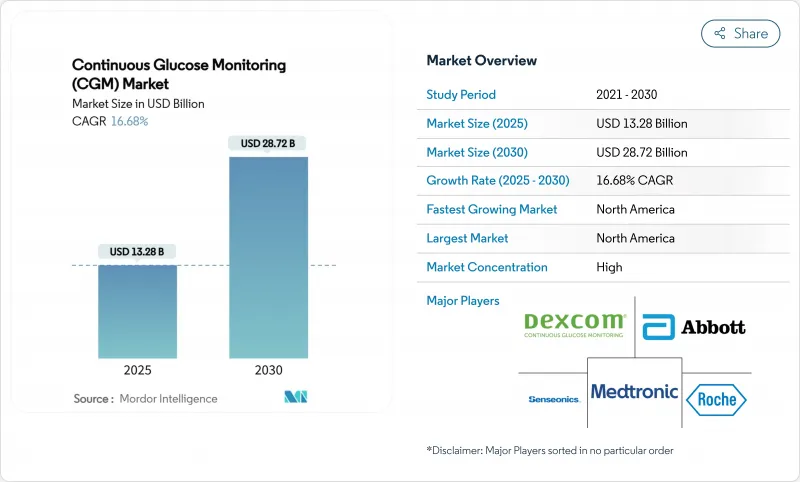
|
市場調査レポート
商品コード
1851759
持続グルコースモニタリング(CGM):市場シェア分析、産業動向、統計、成長予測(2025年~2030年)Continuous Glucose Monitoring (CGM) - Market Share Analysis, Industry Trends & Statistics, Growth Forecasts (2025 - 2030) |
||||||
カスタマイズ可能
適宜更新あり
|
|||||||
| 持続グルコースモニタリング(CGM):市場シェア分析、産業動向、統計、成長予測(2025年~2030年) |
|
出版日: 2025年07月15日
発行: Mordor Intelligence
ページ情報: 英文 118 Pages
納期: 2~3営業日
|
概要
持続グルコースモニタリング市場規模は、2025年に132億7,519万米ドル、2030年には287億1,526万米ドルに達し、CAGR16.68%で成長します。

力強い成長は、センサーの小型化、支援的な償還、消費者のウェルネスと医療上の必要性の融合から生じています。北米が収益をリードしているが、アジア太平洋はスマートフォンの普及と糖尿病有病率の収束に伴い、最速の普及を記録しています。継続的なデバイスとソフトウェアの融合は、ハードウェアと分析サブスクリプションのバンドルに既存企業を誘惑する経常的な収益ストリームを作成します。一方、移植可能で非侵襲的なプロトタイプは、持続的グルコースモニタリング市場が予防や健康志向のユースケースに拡大するとの期待を高めています。
世界の持続グルコースモニタリング(CGM)市場の動向と洞察
糖尿病の有病率の上昇と早期診断
2型糖尿病が患者の96%を占め、アジア太平洋地域では若年化が進んでいるため、発症の中央値が45歳を下回り、数十年にわたるモニタリングの視野が形成されています。人工知能を活用したスクリーニングの強化により、リスクのあるコホートが早期に特定され、予防センサーの使用が促されます。メディケアの2024年政策により、低血糖エピソードを持つ2型患者へのアクセスが開放され、被保険者数が一気に増加しました。すでにCAGR 18.41%で成長している小児科での採用は、介護者が継続的な追跡を学校やスポーツ環境のセーフティネットと見なしているため、この波に乗っています。
遠隔モニタリングと遠隔医療統合の急速な普及
リアルタイムのデータストリームは、臨床医が余分なスタッフなしでより多くの人々を管理することを可能にし、米国のCPTコード償還は、遠隔患者モニタリングキットを配備するプロバイダーに報酬を与えます。米国や欧州の農村部の患者は、長時間のドライブなしで専門医の監視を受けることができ、服薬アドヒアランスと血糖コントロールが向上します。スマートフォンネイティブのアプリは専用受信機のコストを削減し、技術に精通した若いユーザーの障壁を取り除きます。
支払者と患者にとって高額なデバイスと消耗品コスト
10~14日ごとに交換が必要なセンサーは、米国のメディケア受給者にとっては、月100~200米ドルの負担となり、固定収入が圧迫されます。中低所得国では、補助金なしの小売価格が平均月給を上回る。サブスクリプション・モデルは参入コストを下げるが、多くの人々にはまだ手が届かないです。革新的なペイ・パー・ユースやアウトカムベースの契約は、経済的なハードルを軽減する可能性があるが、広範な導入はまだ始まったばかりです。
セグメント分析
センサーは2024年の売上高の84.89%を占め、17.84%のCAGRを達成しました。継続的な材料革新により、消耗品の摩耗寿命は10日から14日に延び、植え込み型は年1回の交換が可能になりました。長寿命化は生涯所有コストを直接的に低下させ、センサーの継続的グルコースモニタリング市場規模をトップライン拡大の主要な原動力にしています。対照的に、トランスミッター・ハードウェアは、Bluetooth Low Energyモジュールとダイレクト・ツー・フォンアーキテクチャがそのレイヤーをコモディティ化したため、CAGRは6.19%にとどまりました。プラットフォームベンダーは現在、トランスミッター機能をセンサーハウジングやスマートフォンアプリにバンドルしており、ユニットマージンを圧迫しているが、セットアップを簡素化することで消費者を魅了しています。
第2世代のセンサー化学は、酵素安定化と高分子膜を活用してドリフトを抑制し、より積極的なインスリン投与アルゴリズムと自動インスリン送達統合を可能にしています。Glucotrack社とSenseonics社の植え込み型ソリューションは、薄型でメンテナンスが容易なデバイスへの移行を強調しており、これによって、これまではサービスが行き届いていなかった職業やスポーツのニッチを開拓できる可能性があります。センサーが半埋め込み式資産に進化するにつれ、ソフトウェア分析とクラウド契約はウォレットシェアを拡大し、価値創造をハードウェアから縦断的データサービスへと軸足を移しています。
地域分析
北米は2024年に51.01%のシェアを維持し、保険の枠組みの定着と高いデバイスリテラシーに支えられています。2030年までのCAGRは18.24%で、73億米ドルの売上増が見込まれます。2024年4月のメディケアの政策により、低血糖が証明された2型糖尿病患者に対象が拡大され、潜在的な成人コホートが掘り起こされ、持続的な販売台数の増加が見込まれます。カナダの単一保険制度は全国的な処方を整え、地方間格差を平滑化し、メキシコの社会保障改革は都市部での機器償還を拡大します。
アジア太平洋は現在18.18%のシェアで、CAGRは16.08%と最も急です。中国の国家償還薬リストは2025年に試験的にセンサーの搭載を開始し、国内メーカーはTier2都市の需要を満たすために規模を拡大しています。インドではスマートフォンの普及率が高く、従量制の保険アプリと相まって家庭の参入障壁が低くなっています。日本と韓国は、家電メーカーがグルコースモジュールを多目的なウェアラブルに組み込んでいるため、一人当たりの摂取率が高いです。
欧州は、国民皆保険制度と協調調達に支えられ、一桁台半ばの成長を示しています。ドイツは1型患者の標準治療としてCGMを支持し、英国のNHS長期計画では、工場で校正されたモデルへのハードウェアのアップグレードに補助金が出る。チェコとポーランドは2025年に試験的な資金調達を導入し、EUの構造基金を活用して糖尿病治療の近代化を図っています。
その他の特典:
- エクセル形式の市場予測(ME)シート
- 3ヶ月間のアナリストサポート
よくあるご質問
目次
第1章 イントロダクション
- 調査の前提条件と市場の定義
- 調査範囲
第2章 調査手法
第3章 エグゼクティブサマリー
第4章 市場情勢
- 市場概要
- 市場促進要因
- 糖尿病有病率の上昇と早期診断
- 遠隔モニタリングと遠隔医療統合の急速な普及
- センサーの小型化と精度の飛躍的向上
- OECDと中国における有利な保険償還の拡大
- 糖尿病と診断された患者を超えたコンシューマー・ウェルネスの拡大
- サブスクリプション価格はLMICの参入障壁を下げる
- 市場抑制要因
- 支払者と患者にとって高額な機器と消耗品コスト
- 較正/データ過多ユーザビリティの懸念
- GLP-1体重減少薬がグルコース検査頻度を減少させる
- サイバーセキュリティとデータプライバシーの脆弱性
- サプライチェーン分析
- 規制情勢
- テクノロジーの展望
- ポーターのファイブフォース
- 新規参入業者の脅威
- 買い手の交渉力
- 供給企業の交渉力
- 代替品の脅威
- 競争企業間の敵対関係
- 有病率指標
- 1型糖尿病人口
- 2型糖尿病人口
第5章 市場規模と成長予測
- コンポーネント別
- センサー
- トランスミッター
- レシーバー
- エンドユーザー別
- 病院/クリニック
- ホーム/ 個人のお客様
- 人口動態別
- 成人用
- 小児
- 地域別
- 北米
- 米国
- カナダ
- メキシコ
- 欧州
- ドイツ
- 英国
- フランス
- イタリア
- スペイン
- ロシア
- その他欧州地域
- アジア太平洋地域
- 日本
- 韓国
- 中国
- インド
- オーストラリア
- ベトナム
- マレーシア
- インドネシア
- フィリピン
- タイ
- その他アジア太平洋地域
- 中東・アフリカ
- サウジアラビア
- イラン
- エジプト
- オマーン
- 南アフリカ
- その他中東・アフリカ地域
- 南米
- ブラジル
- アルゼンチン
- その他南米
- 北米
第6章 競合情勢
- 市場集中度
- 市場シェア分析
- 企業プロファイル
- Abbott Laboratories
- Medtronic plc
- Dexcom Inc.
- Senseonics Holdings Inc.
- F. Hoffmann-La Roche Ltd
- A. Menarini Diagnostics S.r.l.
- i-SENS, Inc.
- Medtrum Technologies Inc.
- Nemaura Medical Inc.
- Zhejiang POCTech Co.,Ltd.
- MicroTech Medical

